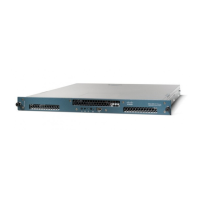Chapter 4 Configuring Class Maps and Policy Maps
Configuring Layer 3 and Layer 4 Class Maps
4-26
Cisco 4700 Series Application Control Engine Appliance Administration Guide
OL-11157-01
When you create a class map, you will enter class map configuration mode. To
classify network traffic passing through the ACE, include one or more of the
following commands to configure the match criteria for the class map:
• description—See the “Defining a Class Map Description” section
• match access-list—See the“Defining Access-List Match Criteria” section
• match any—See the “Defining Match Any Criteria”
• match destination-address—See the “Defining Destination IP Address and
Subnet Mask Match Criteria” section
• match port —See the “Defining TCP/UDP Port Number or Port Range
Match Criteria” section
• match source-address —See the “Defining the Source IP Address and
Subnet Mask Match Criteria” section
• match virtual-address—See the “Defining the VIP Address Match Criteria”
section
Following these guidelines when creating a class map to
define a Layer 3 and
Layer 4 match classification:
• You can include only one match any command within a class map and you
cannot combine the match any command with other types of match
commands in a class map since the other match criteria will be ignored.
• You may combine multiple match access-list, match source-address,
match destination-address, and match port commands in a class map.
• You can include multiple match virtual-address commands within a class
map. The match virtual-address command, however, cannot be combined
with the other types of match commands in a class map. This command is
intended to define a 3-tuple flow of VIP address, protocol, and port as
matching criteria for server load balancing.

